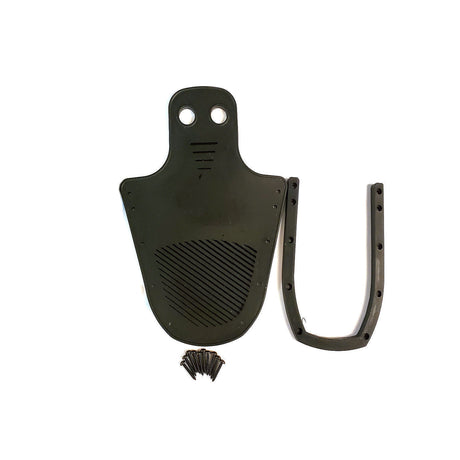We've covered how thick your wetsuit should be based on water and air temperature. But what type of suit should you wear? A shorty suit, with exposed limbs, or a full suit? Is one overall better than the other? When should you pick one or the other?
What's a Shorty Wetsuit?
 Pictured: O'Neill Men's Reactor II Wetsuit
Pictured: O'Neill Men's Reactor II Wetsuit
"Shorty" wetsuit have half sleeves that only cover the upper halves of your arms. They usually terminate somewhere between the bicep and elbow. Shorty suits' legs also end above the knee, covering only the thighs. "Shorty" suits are officially called spring suits, since they're typically worn in warmer weather.
Advantages of a Short Wetsuit
Besides the temperature factor, there are plenty of other reasons you might pick a shorty suit over a full suit.Better Mobility
All wetsuits are made from neoprene, which is a spongy, springy, and slightly stiff material. Coupled with the fact that wetsuits are designed to fit tightly, it can be surprisingly difficult to flex, bend, and generally maneuver while wearing one.
If you're into watersports -- especially water skiing, surfing, or wakeboarding -- then this can play a big factor in what type of suit you wear. A short wetsuit will provide far better mobility than a full suit, especially around your joints, when you're riding.
Easier to Wear
Short suits are a pain to put on and take off. If you're experienced with any wetsuit, you know it never really gets easier. The shorty setup makes the task of squeezing in and out of your suit a little less frustrating. This can be surprisingly helpful if you're onboard a small watercraft.
Dries Quicker, Cleans Easier
The theme of convenience continues, here. Short wetsuits dry far quicker, and they're easier to clean.
Drawbacks of a Short Wetsuit
A short suit isn't without its drawbacks. If any of these are deal-breakers, you might need a full suit.
Less Insulation
Obviously, less neoprene means less insulation against the termperatures of the open water. Of course, this is only a concern if you're in the water at night or during cooler days, or if there's a wind chill.
Less UV Protection
Since short wetsuits don't cover the full length of your arms and legs, you're going to get direct exposure to harmful UV rays throughout the day. If you stick with a short suit, make sure you've got some decent SPF sunscreen on hand, or limit your time in the water on cloudless days.
Less Protection Against Marine Life
Tropic swimmers and surfers know that jellyfish encounters can be surprisingly common. Wetsuits can provide great protection against a wayward stinger -- but the short suit won'tt provide protection for your lower arms and legs, where you're most likely to get stung.
What's a Full Wetsuit?
 Pictured: Body Guard Men's Full Wetsuit
Pictured: Body Guard Men's Full Wetsuit
A full wetsuit covers the entire body, save for the hands and feet. The sleeves provide full arm coverage down to the wrists, and the legs extend down to ankles. Some full suits may also include a hood for the head.
Advantages of a Full Wetsuit
Like the short suit, there are other reasons you might want to wear a full wetsuit -- even if the temperatures might otherwise allow for wearing a short suit.Better Insulation
Self explanatory. The full suit's main purpose is to provide insulation for your core and the full length of your arms and legs. The full suit's also a great choice even if you're above the water on a board or ski -- it'll help protect against wind chill effectively, too.
More UV Protection
Full wetsuits provide complete UVA and UVB protection. Besides insulation, this is the primary reason swimmers, divers, water skiers, wakeboarders and surfers choose to wear a full wetsuit year-round, no matter the water temperature.
Protection From Stingers
Paddling out in tropic waters always comes with at least a small risk of a jellyfish encounter. The full suit will dramatically reduce the risk of getting hit by a stinger on your bare skin.
More Buoyancy
Full wetsuits are more buoyant than short suits, which can make diving and swimming easier. This extra buoyancy will also help keep your head above water after a wipeout when you're surfing, skiing, or wakeboarding.
Drawbacks of a Full Wetsuit
Despite the extra protection it affords, a full suit may not always be the best choice.
Less Maneuverable
The more neoprene you wear, the stiffer your suit will be -- and the less maneuverability you'll enjoy. Suit thickness plays a role here, too. But the full wetsuit will, overall, be less flexible than a short wetsuit.
More Difficult to Wear
The ankle and wrist holes in a full wetsuit's arms and legs are tiny, with lots of stretch. Coupled with the added sleeve and leg length itself, getting in and out of a full wetsuit can be a proper pain compared to a short suit.
More Difficult to Dry & Clean
Full suits require a little extra elbow grease to dry and clean. Because of their longer sleeves and legs, and smaller holes, failing to let a full suit air out can result in mold growth and mildew.
Looking for a "shorty" or full wetsuit? Grab them here!
Not sure how thick your wetsuit should be? Read our next guide here.












